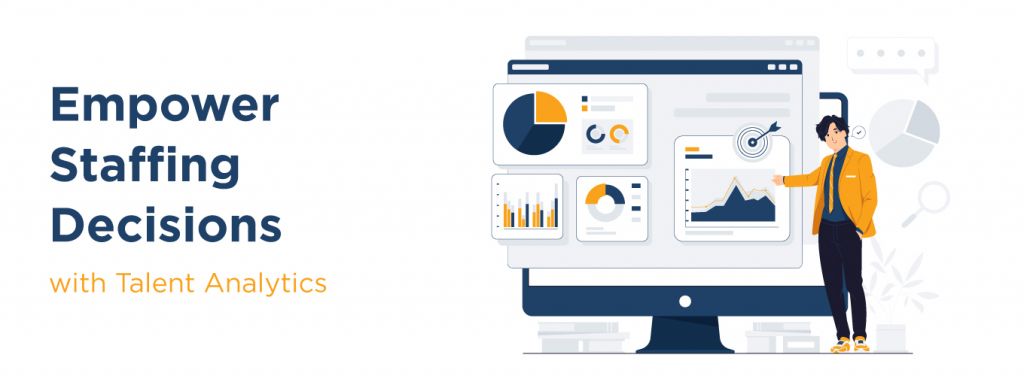In the dynamic field of human resources today, talent analytics have become crucial for informed staffing selections. Leveraging data helps organizations identify suitable candidates, streamline their recruitment, and align hiring strategies with broader objectives. In this article, we will delve into the significance of talent analytics in contemporary HR departments, and its role in augmenting the effectiveness of staffing choices.
Table of Contents
Why should we empower decision-making in talent analytics in staffing?
In the context of modern business, the talent landscape is undergoing a myriad of changes. Low-quality recruitment methods, which used to be based on the managers’ guts and personal feelings, are no longer acceptable. Empowering decision-making talent analytics brings a myriad of benefits, including:
Efficiency and Precision
Talent analytics enables organizations to fix the most viable recruitment approaches by leveraging this. This also improves the speed and hence, fills up positions with the qualifiers soon. Which in turn improves the efficiency of staffing to a great extent.
Cost Reduction
Data-driven, evidence-based decision-making in staffing ensures the best possible use of budget. Efficiency in staffing can be reached by determining the most cost-effective channels for talent acquisition and assessing the return on investment (ROI) from recruitment initiatives to reduce unjustifiable expenses.
Enhanced Candidate Experience
Through analytics, organizations can understand candidate behavior and make recruitment processes more tailored to specific candidates, which will lead to a more friendly and personalized experience. It does this through a combination of a good level of pay and setting attractive employee terms, this in turn attracts first-rate talent and improves the employer’s brand.
Mitigation of Bias
Talent analytics can enable neutralizing of the unconscious biases in the recruitment process. Through utilizing data-driven insights, the organizations can guarantee impartial and unbiased decision making which helps to reinforce diversity and inclusion.
Strategic Workforce Planning
Human capital analytics offer organizational leaders with workforce data that contributes to the design and implementation of workforce management strategies that align with long-term business objectives. Here, the future workforce needs are “seen” in which proactive workforce planning and development is executed.
Identifying High-Performing Traits
Using analytics organizations can pinpoint variables and skills that are common for high-performing individuals in specific positions. This data helps in effective job descriptions, assessments, and evaluation criteria which are used as a basis to select candidates.
Predictive Recruitment
Consequently, organizations can capitalize on predictive analytics to predetermine future talent requirements. Through historical data and market trend analysis, workforce problems are nipped in the bud and future staffing requirement plans are made accordingly. After all, gone are the days when a resume was enough to garner a job. Times have changed and so has staffing.
Continuous Improvement
Talent analytics helps in the development of a culture of continuous improvement by providing feedback about recruitment strategies. Through an interpretation of data, companies can spot areas for improvement and implement iterative corrections.
Adaptability to Market Changes
In a fast-paced labor market, predicting trends is indeed vital. Talent analytics makes organizations change ready to suit the ever-evolving talent landscape, thus, keeping them competitive and responsive to the dynamic and changing industry needs.
Customized Training and Development
Analytics can create an array of cumulative needs for skill upgrades in the workforce. By focusing on the required skills for future success, the organization can run sport-specific training and development programs to upskill its employees.
Strategies for Powerful Decision-making in Talent Analytics Hiring
Define Clear Objectives
Undoubtedly, set the goals for your strategy. Regardless of whether it’s recruiting faster, more inclusive, or better candidate experience, the identified goals guide the recruitment process.
Data Quality and Integration
Establish the data accuracy and integration among each of the HR systems. For obtaining reliable findings and making appropriate options, it is crucial to have datasets of good quality and cleanliness.
Identify Key Metrics
Identify the critical performance indicators (KPIs) that correlate with the target staffing. Metrics may include time-to-fill, cost-per-hire, quality-of-hire, and diversity indexes. Track and analyze these metrics rigorously and continuously for improvements.
Leveraging AI and ML.
Tap AI and ML technologies to promote the prognostic abilities of talent analytics. These are some technologies that process a huge amount of data in a short time, detect patterns, and provide insights that are not seen in traditional analysis.
Embrace Diversity Analytics
Take diversity analytics into account while designing your talent acquisition strategy. This means monitoring and reflecting on diversity indicators so that we can be sure that fair and inclusive recruitment practices are being followed.
Invest in Training and the Process of Professional Growth
Make sure human resource professionals get the skills necessary to correctly interpret and use talent analytics. The investment in training programs teaches your team how to properly use data so that they can make well-founded staffing decisions.
Create Data-Driven Recruitment Processes
Rethink the recruitment processes to consist of data-driven acts. This involves applying analytics to improve job descriptions, evaluate the suitability of a candidate, and determine the most efficient channels for recruiting a suitable candidate.
Encourage partnerships between Human Resources and Information Technology.
The joint HR-IT collaboration is the most important part of successful talent analytics implementation. IT professionals have the capability of data integration, system customization, and implementation of advanced analytics techs.
Regularly Review and Update Strategies: Regularly Review and Update Strategies:
The talent landscape is ever-changing, and so should the data analytics strategies. Frequently revise and upgrade your approaches to be in line with the most recent industry evolutions and client feedback, the business goals.
How can a Company Use These Tools for the Implementation?
When it comes to staffing and its implementation, it is important to identify tools that a company can use to enhance their staffing and effectively empower decision making and make the best use of talent analytics in order to hire the right people, for the right job.
Here are some ways through which, on can implement Talent Analytics in Staffing and empower their decision – making:
Invest in Technology
Implement a balanced talent analytics platform that fits the needs of your organization. Embed technologies that provide telemetry, data analytics, and visualization capabilities.
Build Analytical Competencies
Train HR professionals in data analysis to bring them to the same level of business intelligence. This encompasses some of the courses such as data interpretation, statistical analysis, and analytics tools.
Establish Data Governance
This will be achieved through the implementation of data governance policies to maintain data accuracy, security, and compliance. Create data collection protocol for storage and use ensuring data integrity.
Collaborate Across Departments
Align HR, IT, and other stakeholder business functions to work together. Form cross-functional teams to sustain the alignment in the implementation of talent analytics strategies.
Pilot Programs
Undertake a pilot testing of the selected talent analytics processes for their efficacy. This ensures that modifications are incorporated in real-time based on field feedback to fully implement.
Seek External Expertise
Think about other people’s opinions or employ talent analytics professionals to develop the process. Access to outside experts can provide some deep insights which can greatly increase the speed of the learning curve of an in-house team.
Communicate and Train
Educate the benefits of talent analytics to all the stakeholders. Ensure that the training is thorough to cover HR managers, executives, and key managers to create buy-in and adoption.
KPIs (key performance indicators) should be established.
Determine and monitor KPIs for evaluating the effectiveness of talent analytics programs. Regularly evaluate the impact on recruitment processes, employee satisfaction, and business performance among other outcomes.
Iterative Improvement
Adapt an iterative change. Frequent evaluation of talent analytics strategies, induction of feedback, and regular updates to keep the strategy in line with organizational goals are a must.
Promote a Data-Driven Culture
Build a culture that employs data-driven and decision-making systems. Foster a more agile workplace culture that is driven by data at all levels and inspires employees from the bottom to the top to make decisions based on the information, resulting in an agile environment that is more adaptive and proactive.
Conclusion
To sum up, talent analytics facilitating decision-making in staffing is no longer just a trend, but it is an imperative for strategic organizations leading in turbulent business environments. As we implement these techniques and methods we can be sure of growth and better decision making when it comes to staffing.
Frequently asked questions
1. What is the rationale behind talent analytics as a key component of modern staffing strategies?
Talent analytics thus plays a crucial role as it enables organizations to strategically make decisions based on evidence, improve their recruitment processes, and synchronize the staffing practices with the macro-level objectives of the business. It helps to incorporate a data-driven approach for talent management which in turn enhances the efficiency and precision of the recruitment process.
2. What does talent analytics do to remove biases from the process of recruitment?
Talent analytics aids in bringing to the fore and reducing unconscious biases by using data-driven analysis. This makes sure that all people are treated equally and appropriately during the hiring process, therefore promoting diversity and inclusion within the organization.
3. What are the top KPIs organizations should analyze in terms of talent?
Key performance indicators (KPIs) i.e. time-to-fill, cost-per-hire, quality-of-hire, and diversity ratios are the crucial metrics that should be tracked for talent analytics. Monitoring such numbers on a routine basis helps the organization to make informed decisions and to refine its recruitment strategies continuously.









